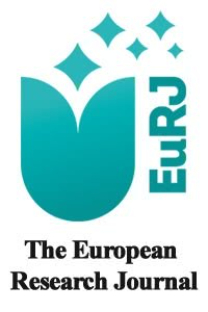The effect of nasal steroids on retinal nerve fiber layer in patients with a family history of glaucoma
The effect of nasal steroids on retinal nerve fiber layer in patients with a family history of glaucoma
Mometasone furoate, fluticasone propionate intraocular pressure, retinal nerve fiber layer thickness,
___
- 1. Baroody FM. Allergic rhinitis: broader disease effects and implications for management. Otolaryngol Head Neck Surg 2003;128:616-31.
- 2. Naclerio RM, Baroody FM, Bidani N, De Tineo M, Penney BC. A comparison of nasal clearance after treatment of perennial allergic rhinitis with budesonide and mometasone. Otolaryngol Head Neck Surg 2003;128:220-7.
- 3. Salib RJ, Drake-Lee A, Howarth PH. Allergic rhinitis: past, present and the future. Clin Otolaryngol Allied Sci 2003;28:291-303.
- 4. Mygind N, Lund V. Intranasal corticosteroids for nasal polyposis : biological rationale, efficacy, and safety. Treat Respir Med 2006;5:93-102.
- 5. Man LX, Farhood Z, Luong A, Fakhri S, Feldman RM, Orlander PR, et al. The effect of intranasal fluticasone propionate irrigations on salivary cortisol, intraocular pressure, and posterior subcapsular cataracts in postsurgical chronic rhinosinusitis patients. Int Forum Allergy Rhinol 2013;3:953-7.
- 6. Bross Soriano D, Arrieta Gómez JR, Schimelmitz Idi J, Guzmán Urrutia R, Hanenberg Milver C. [Changes in intraocular pressure with the use of topical nasal mometasone furoate]. Rev Alerg Mex 2000;47:12-6. [Article in Spanish]
- 7. Alsaadi MM, Osuagwu UL, Almubrad TM. Effects of inhaled fluticasone on intraocular pressure and central corneal thickness in asthmatic children without a family history of glaucoma. Middle East Afr J Ophthalmol 2012;19:314-9.
- 8. Desnoeck M, Casteels I, Casteels K. Intraocular pressure elevation in a child due to the use of inhalation steroids--a case report. Bull Soc Belge Ophtalmol 2001;280:97-100.
- 9. Nuyen B, Weinreb RN, Robbins SL. Steroid-induced glaucoma in the pediatric population. J AAPOS 2017;21:1-6.
- 10. Kersey JP, Broadway DC. Corticosteroid-induced glaucoma: a review of the literature. Eye (Lond) 2006;20:407-416.
- 11. Halpern DL, Grosskreutz CL. Glaucomatous optic neuropathy: mechanisms of disease. Ophthalmol Clin North Am 2002;15:61-68.
- 12. Mitchell P, Cumming RG, Mackey DA. Inhaled corticosteroids, family history, and risk of glaucoma. Ophthalmology 1999;106:2301-6.
- 13. Rolle T, Dallorto L, Briamonte C, Penna RR. Retinal nerve fibre layer and macular thickness analysis with Fourier domain optical coherence tomography in subjects with a positive family history for primary open angle glaucoma. Br J Ophthalmol 2014;98:1240-4.
- 14. Zhang HG, Ying GS. Statistical approaches in published ophthalmic clinical science papers: a comparison to statistical practice two decades ago. Br J Ophthalmol 2018;102:1188-91.
- 15. Sullivan GM, Feinn R. Using effect size-or why the P value is not enough. J Grad Med Educ 2012;4:279-82.
- 16. Taner P, Bayar N, Akarsu C, Koç C. [Effect of topical nasal corticosteroids used for the treatment of allergic rhinitis to the intraocular pressure]. KBB ve BBC Dergisi 2001;9:21-4. [Article in Turkish]
- 17. Şimşek A, Bayraktar C, Doğan S, Karataş M, Sarıkaya Y. The effect of long-term use of intranasal steroids on intraocular pressure. Clin Ophthalmol 2016;10:1079-82.
- 18. Oztürk F, Yücetürk AV, Kurt E, Unlü HH, Ilker SS. Evaluation of intraocular pressure and cataract formation following the long-term use of nasal corticosteroids. Ear Nose Throat J 1998;77:846-848.
- 19. Martino BJ, Church CA, Seiberling KA. Effect of intranasal dexamethasone on endogenous cortisol level and intraocular pressure. Int Forum Allergy Rhinol 2015;5:605-9.
- 20. Yuen D, Buys YM, Jin YP, Alasbali T, Trope GE. Effect of beclomethasone nasal spray on intraocular pressure in ocular hypertension or controlled glaucoma. J Glaucoma 2013;22:84-7.
- 21. Opatowsky I, Feldman RM, Gross R, Feldman ST. Intraocular pressure elevation associated with inhalation and nasal corticosteroids. Ophthalmology 1995;102:177-9.
- 22. Seiberling KA, Chang DF, Nyirady J, Park F, Church CA. Effect of intranasal budesonide irrigations on intraocular pressure. Int Forum Allergy Rhinol 2013;3:704-7.
- 23. Mohd Zain A, Md Noh UK, Hussein S, Che Hamzah J, Mohd Khialdin S, Md Din N. The relationship between long-term use of intranasal corticosteroid and intraocular pressure. J Glaucoma 2019;28:321-4.
- 24. Bross-Soriano D, Hanenberg-Milver C, Schimelmitz-Idi J, Arrieta-Gomez JR, Astorga del Toro R, Bravo-Escobar G. Effects of three nasal topical steroids in the intraocular pressure compartment. Otolaryngol Head Neck Surg 2004;130:187-91.
- 25. Maeng MM, De Moraes CG, Winn BJ, Glass LRD. Effect of topical periocular steroid use on intraocular pressure: a retrospective analysis. Ophthalmic Plast Reconstr Surg 2019;35:465-468.
- 26. Marzouki HZ, AlThomali RK, Hefni L, Almarzouki N, Alhejailli F, Merdad M, et al. Effect of intranasal corticosteroids on intraocular pressure and nerve fiber layer thickness: a cross-sectional study at a tertiary care hospital in Western Saudi Arabia. Cureus 2021;13:e13146.
- 27. Ozkaya E, Mete F, Ozsutcü M, samanci N, Cekiç O. Evaluation impact of long-term usage of inhaled fluticasone propionate on ocular functions in children with asthma. Steroids 2011;76:548-52.
- ISSN: 2149-3189
- Yayın Aralığı: 6
- Başlangıç: 2015
- Yayıncı: Prusa Medikal Yayıncılık Limited Şirketi
The relationship between sustainable nutrition and healthy food choice: a cross-sectional study
Evaluation of optic nerve by histogram analysis on MRI in patients with isolated optic neuritis
Seda Nida KARAKÜÇÜK, Adil DOĞAN, Murat BAYKARA, Selma URFALIOGLU
Yaprak DÖNMEZ ÇAKIL, Zeynep AKBULUT, Gamze DEMİREL, Ranan GÜLHAN, Zeynep OZUNAL
Orhan GÜVENÇ, Mesut ENGİN, Irem Iris KAN, Senol YAVUZ
Efficacy of topical mineralocorticoids in a rabbit model of ocular inflammation
Bone turnover markers and bone mineral density in patients with type 2 diabetes
Aysen AKALIN, Göknur YORULMAZ, İ. Özkan ALATAŞ, Kevser ONBAŞI, Fatma Belgin EFE
Filiz ATA, Canan YILMAZ, Ümran KARACA, Buket ÖZYAPRAK, Ayşe Neslihan BALKAYA, Cihan Sedat AYTÜNÜR, Tuğba ONUR
Fatma BAKIR, Özge Selin ÇEVİK, Seval MÜSÜROĞLU KELOĞLAN, Leyla ŞAHİN
